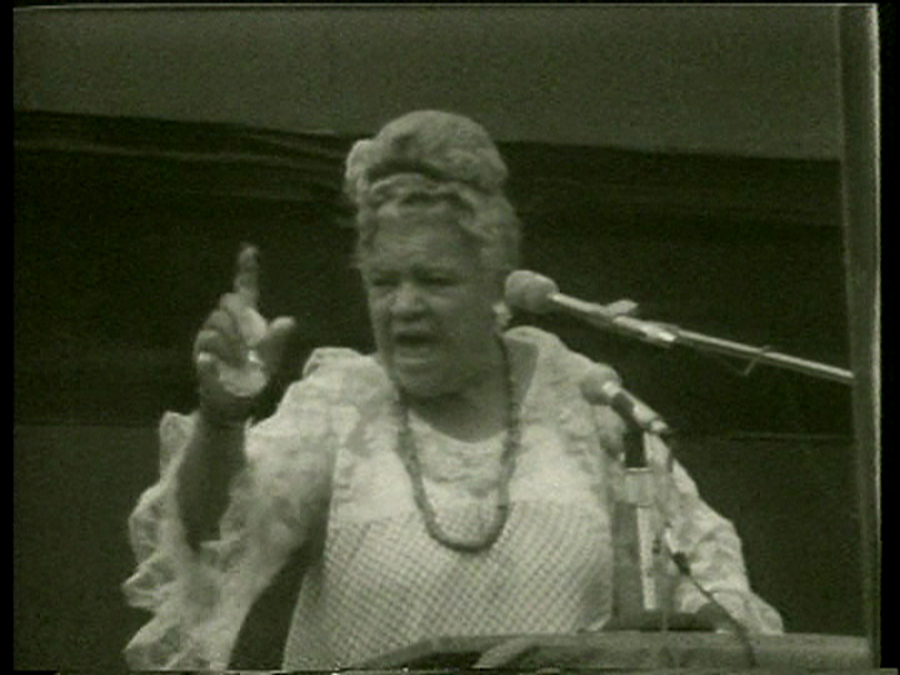like baking bread or slaughtering animals”
– Harun Farocki
This is the last piece in the 3 part series I have written for TPW R&D’s discursive screening series, What We Talk About When We Talk About History. This week, my approach is a little different because I was not present for the screening on March 27, which included: Queen Mother Moore Speaks at Green Haven Prison (1973) by People’s Communication Network, I Thought I was Seeing Convicts (2000) by Harun Farocki and Corrections (2001) by Ashley Hunt. Instead of responding to the interplay between the videos and the audience, I offer an interpretation of power’s circulation in the films, in keeping with the thematics of power, visibility, translation and transmission.
In a distinction from past weeks, the series of films screened in the third installment of the series were all focused on prisons. These pieces ranged from the documentation of Queen Mother Moore’s speech in Green Haven prison, to artist Harun Farocki’s exploration of prison images using surveillance footage, and finally to the documentary film Corrections, which overtly explores the prison industrial complex in the United States.
I return to a question I posed in an earlier entry, how does power operate through the act of looking in these films? Looking, seeing, viewing, making visible, all acts and gestures intertwined with power and knowledge. In Queen Mother Moore Speaks… power circulates through the People’s Communication Network, who gained access to the prison yard and to the bodies contained behind the walls. At another layer, the power in Queen Mother’s speech attests to the strength of the Black power movement and the transference of power from white supremacy towards the shifting black bodies who fought for social change. And yet, power’s circulation does not stick the way we would like it to, as we are all too well aware of the ongoing struggle of racial injustice that is translated by neoliberalism into moments of tokenism.
Corrections speaks directly to the profits gained by mega corporations who build, equip, and fill prisons. Foremost, the film speaks to the power of capitalism and the ways that it engulfs those who are vulnerable, never ceasing its grip.
Farocki’s video, I Thought I was Seeing Convicts, toyed with the complex layers of “seeing” and power play. The film, comprised of surveillance footage from prisons, places the viewer and Farocki himself in the position of power through the placement of the cameras and the monitoring nature of the devices themselves. The entire film speaks to the devices of control used on prisoners, from anklet bracelets to controls of desire during visits from external family members. Farocki calls these controls “gestures of love.” He points to the obvious control of movement spatially – within and between the walls, bars and gates of the prison structure itself.
Formally, I Thought I Was Seeing Convicts compels us through the way it situates information on the screen, layering it with image, text and sound. The piece reveals personal stories and speaks about the prison industrial complex conceptually. The use of found footage mixed with surveillance footage adds to the rich narrative of the piece, laying bare the systems of control and oppression that are enacted on the bodies of those incarcerated.
All three films expose the power structures of the American prison system, which are inherent to, and complicit with contemporary modes of capitalism. The videos state and re-state that the bodies that are held captive under these oppressive modes, are those that threaten dominant structures of power.
I would like to conclude this series on an optimistic note. It encompasses the work that we have seen over the last 3 weeks, the conversations that accompany them and also marks our contemporary moment that is rife with uncertainty and a sense of the apocalyptic. Small gestures and small moments, are perhaps the very things we need to remind ourselves of the greater picture. As Martin Luther King so eloquently put it, “one of the greatest problems of history is that the concepts of love and power are usually contrasted as polar opposites. Love is identified with a resignation of power and power with a denial of love. What is needed is a realization that power without love is reckless and abusive and that love without power is sentimental and anemic. Power at its best is love implementing the demands of justice. Justice at its best is power correcting everything that stands against love.”










